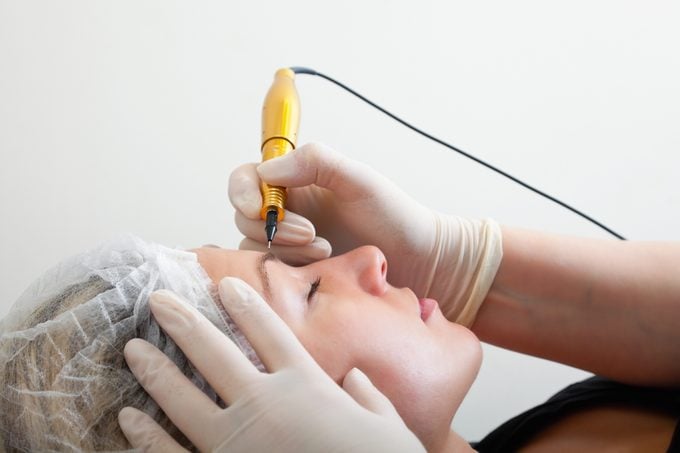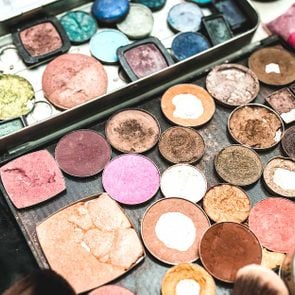How Safe Is Permanent Makeup?
Updated: Apr. 12, 2021
Permanent makeup, like eyebrow microblading, is a trend right now. Here's what you need to know about having semi-permanent pigment applied to your eyes, lips, or brows, including safety tips and how long it lasts.
The rise of permanent makeup
Big, bushy eyebrows have been popular for a while now but unless you’re genetically blessed, following this trend may mean spending a lot of time and money plucking, shaping, gelling, coloring, and drawing on those cute caterpillars.
One efficient solution many people turn to is microblading, a type of semi-permanent makeup that uses tattoo techniques to give you your ideal brows, no daily products necessary.
This type of procedure—which can last for years, but not forever—can also be done to semi-permanently apply many types of makeup. Sound like a dream? Here’s everything you need to know if you’re considering getting it done.
Cosmetic vs. paramedical
There are two types of micropigmentation procedures, commonly known as “permanent makeup.” Paramedical permanent makeup is done to reconstruct a body part after surgery or an injury—like getting realistic nipples tattooed on reconstructed breasts after a mastectomy or covering the scar left from a cleft palate surgery.
However, most permanent makeup is purely cosmetic and is usually done to enhance brows, eyes, and lips.
You can also get things like freckles and beauty marks tattooed on, a hairline adjusted, or even get stretch marks camouflaged, says Genn Shaughnessy, a makeup artist experienced in doing permanent makeup, professional movie and TV stylist, and founder of The Backstage Stylist.
Eyebrow enhancements—microblading, machine shading, and ombré brows—are the most popular type of permanent makeup these days but lip liner and shading, and subtle eyeliner are also popular, she says.
Costs can vary widely but generally range from $50 for a small touch-up to $1,000 for a full face.
It’s not a regular tattoo
Permanent makeup uses pigment instead of traditional tattoo ink. Pigments are a different formulation and are semi-permanent. They can last up to eight years for scalp micropigmentation and one to three years for brows, lips, and face, whereas tattoo ink is permanent.
The technician uses a permanent makeup pen instead of a tattoo gun to apply the pigment. The pen is a rotary machine with needle cartridges. It doesn’t make the loud buzzing noise like a tattoo gun and clients generally find it more comfortable, Shaughnessy says.
Unlike a normal tattoo, the goal of both types of permanent makeup is to look realistic and not call attention to the art itself. Done right, you shouldn’t even notice that you’re looking at a tattoo.
Is permanent makeup safe?
Although permanent makeup is generally quite safe, all types of tattoos come with some health risks so it’s important to weigh the pros and cons before deciding to do it, says Howard Sobel, MD, an attending dermatologist and dermatologic surgeon at Lenox Hill Hospital in New York.
“Don’t do it to follow a trend, ask yourself why you specifically want it or how it will add to your overall appearance,” he says.
Infection
There is always a chance for infection and bleeding when it comes to permanent makeup, as the needle is breaking the skin, says Dr. Sobel.
Allergic reaction
If you have sensitive skin, there is a chance that you may experience a poor reaction to the pigments. This can cause inflammation, redness, pain, swelling, a rash, or itching at the site of the tattoo. Rarely it can cause a true allergic reaction, usually to something in the dye, resulting in hives or anaphylactic shock.
Scarring
All tattoos can cause permanent scarring.
Some people are prone to keloids—a type of lumpy scar caused by excess protein as a healing response to an injury—and your body may see the tattoo as an “injury,” adds Dr. Sobel.
Keloids are benign but are often unsightly and your face is probably the last place you want to have one. If you know you’re prone to them, avoid getting permanent makeup.
Injuries
Permanent makeup can cause a range of injuries from the pigments, the technique, or the equipment used, or from a mistake or accident, says Dr. Sobel.
These can be slight, like loss of eyelashes or eyebrow hair, but can also be more serious like an injury to your eyeball or eyelid, cuts, bruises, or an ectropion—a condition where your eyelid turns inside out.
Pain
This procedure is typically less painful than a regular tattoo but that doesn’t mean it’s painless. Some clients find the sensation to be painful, irritating, frightening, or otherwise upsetting, says Dr. Sobel. If you’re concerned about how you’ll react, ask for a consultation with the practitioner beforehand so you’ll know exactly what to expect.
(These are the most and least painful places to get a tattoo.)

Not everyone is a good candidate for permanent makeup
Dr. Sobel advises you avoid getting any type of micropigmentation procedure:
-
If you have any type of skin condition such as eczema, dermatitis, rosacea, or psoriasis
-
If you are on isotretinoin, a prescribed oral acne medication often referred to as its former brand name, Accutane. This medicine thins the outer layer of the skin, making it dry and sensitive
-
If you have an autoimmune condition like lupus or inflammatory arthritis, or have a compromised immune system
-
If you have a current viral or bacterial skin infection or disease. It must be treated and resolved first.
-
If you have a known allergy to metals or colorants
What to look for in a practitioner
Much of the final result of permanent makeup depends on the person doing the procedure and the environment it’s done in.
Practitioners can be aestheticians, physicians (like a dermatologist or plastic surgeon), tattoo artists, or makeup artists. Make sure the person you select has the same vision as you and let them know if you have any medical or skin conditions.
Locations can vary widely from a standard tattoo parlor to a doctor’s office to a high-end boutique spa. Here’s what to look for before booking an appointment:
They are following regulations
“There are many aestheticians, tattoo artists, makeup artists, and physicians who offer micropigmentation procedures, so be sure to do prior research on these practitioners,” says Dr. Sobel. It’s important to check that they are licensed and/or following all local regulations.
They are experienced
The most important factor in picking an artist isn’t necessarily what their job title is but rather how many times they’ve done it. Permanent makeup requires a different technique, equipment, and training than regular tattoos or other cosmetic procedures and it’s a learned skill. You don’t want your face to be their guinea pig.
They willingly provide pictures and client referrals
There’s a lot of artistry involved in these procedures and the outcome is semi-permanent so take time to research the technician and make sure their style and technique is what you’re looking for.
“You want someone whose procedures give natural results,” says Dr. Sobel. “Schedule a consultation first, and check their sites and social media for before and after pictures.”
The place is sparkling clean
You’re putting little holes in your skin which can make you more vulnerable to infections so cleanliness is very important. Before sitting down, check out the place.
Does the space look clean? Do they follow all public health and safety protocols, including Covid-19 guidelines if applicable? Do they sanitize the workstation and all equipment between clients? If you have any doubts go somewhere else.
They use high-quality pigments
It doesn’t matter how good the makeup artists technical skills are if they use cheap pigments. Pigment quality varies based on manufacturers and one significant way they differ is in color fastness, says Shaughnessy.
“It’s important for me to use inks that have the same color fastness, so all pigments in the ink fade at the same rate, and my clients won’t have salmon colored brows after the first year,” she says.
How to take care of permanent makeup
You can get the best permanent makeup done by the best artist and it can still end up looking wonky or getting infected if you don’t take care of it properly.
Give it time
Most permanent makeup procedures take three to five days to heal. During this time you should avoid covering it with anything not recommended by the technician including lotions or other types of makeup. It also takes a few days to settle and for the inflammation to go down so you won’t see your full results right away.
Follow all after-care directions
Your artist should give you a printed set of after-care instructions about how to keep the area clean and covered while it heals. It will depend on which part you got inked, what procedure you had done, and other individual factors. Follow those instructions to the letter.
Don’t cover it with a dirty mask
A common mistake these days is covering a freshly tattooed face with a dirty face mask—a huge no-no as it can introduce bacteria into your wound and cause an infection or slow healing, says Shaughnessy. Make sure all face coverings are sterile.
Avoid tanning beds and the sun
Pigments will fade from sun exposure, tanning beds or any source of UV light. Avoid these until your makeup is healed and then wear sunscreen every time you go out, says Shaughnessy.
Schedule touch-ups
Permanent makeup should be touched up about every six weeks to keep it looking its best, says Shaughnessy.
Getting your eyebrows filled in or your eyeliner put on with semi-permanent pigment can be an efficient and cost-effective solution for people who want to enhance or simply skip daily makeup application. Just make sure you are a good candidate for the procedure, find a good technician, and take care of it properly afterwards.
Next, avoid these dangerous beauty trends.

















